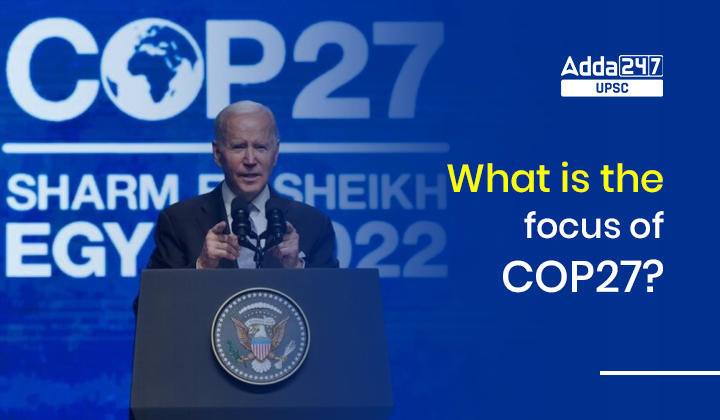Table of Contents
Significance of COP 27 for UPSC
- All nations that signed Paris Agreement on Climate Change of 2015(at COP 26) under the UN Framework Convention on Climate Change (UNFCCC) are meeting in Sharm elSheikh, Egypt, at the COP27, to review progress, raise ambition on emissions cuts and draw up funding plans to help vulnerable countries adapt to climate change.
For UPSC examination purpose, COP 27 and related happenings are must read for every serious aspirant.
COP 27 is an important part of GS 2: Important International Institutions and GS 3: Environmental Conservation.
What is COP27?
- United Nations (UN) climate summits are held every year, for governments to agree steps to limit global temperature rises.
- They are referred to as COPs, which stands for “Conference of the Parties“. The parties are the attending countries that signed up to the original UN climate agreement in 1992.
- COP27 is the 27th annual UN meeting on climate. It is taking place in Sharm el-Sheikh until 18 November.
What is special about COP 27 from previous COPs?
- The COP27 is described as the conference of implementation, given that UN climate talks are often criticised as a ‘talk more, do little’ exercise.
- After the ratification of the Paris Agreement on Climate Change of 2015, the focus is on voluntary national actions to drive down greenhouse gas emissions and keep the rise in average global temperature to well below 2°C and as close to 1.5°C as possible by the end of the century.
What about 1.5°C target?
- Scientific reports from the UN released ahead of the COP27 meeting in Egypt point to the extremely narrow window available to close the emissions gap and prevent rise in average global temperature beyond 1.5°C.
- The UNEP’s Emissions Gap Report 2022 says, even if all the conditional Nationally Determined Contributions (NDCs) — voluntary pledges submitted under the Paris pact — followed by targets to reduce emissions to netzero are implemented, global warming is projected to rise to 1.8°C with a 66% probability.
- The report also points out that global annual emissions during 2021 at 52.8 Gigatonnes (GtCO2e), represents a slight increase compared to 2019, the preCOVID year, and that the outlook for 2030 is not bright.
- Current temperature rise stands at 1.2°C to 1.3°C over the preindustrial average, the highest in about 12,000 years since the last Ice Age.
- With the present soft approaches to limiting atmospheric CO2, it will be almost impossible to achieve the 1.5°C target.
The alarming Sixth Assessment Report (SAR) of the IPCC
|
What is the Focus of COP 27?
- At COP 27, countries most affected by the effects of a changing climate have been seeking loss and damage payments from the richer industrialised nations, who have contributed the bulk of CO2 in the atmosphere. Firming up this compensation mechanism is a major area of focus at Sharm elSheikh.
- So, COP27 will focus on three main areas:
- Reducing emissions
- Helping countries to prepare for and deal with climate change
- Securing technical support and funding for developing countries for the above.
- Some areas not fully resolved or covered at COP26 will also be picked up:
- Loss and damage finance – money to help countries recover from the effects of climate change, rather than just prepare for it.
- Establishment of a global carbon market – to price the effects of emissions into products and services globally.
- Strengthen the commitments to reduce coal use.
FAQs
Q. What is 1.5°C target?
Ans: The 1.5 °C target is the target of Paris Agreement 2015 to close the emissions gap and prevent rise in average global temperature beyond 1.5°C.
Q. When Paris Agreement on Climate Change was ratified?
Ans: Paris Agreement on Climate Change was ratified in the year 2015.
Q. What is COP 27?
Ans: COP27 is the 27th annual UN meeting on climate.
Q. Where did COP 27 held and why?
Ans: COP 27 held at Sharm elSheikh, Egypt to review progress, raise ambition on emissions cuts and draw up funding plans to help vulnerable countries adapt to climate change.
Mangrove Alliance for Climate (MAC) launched at UNFCCC COP 27




 TSPSC Group 1 Question Paper 2024, Downl...
TSPSC Group 1 Question Paper 2024, Downl...
 TSPSC Group 1 Answer key 2024 Out, Downl...
TSPSC Group 1 Answer key 2024 Out, Downl...
 UPSC Prelims 2024 Question Paper, Downlo...
UPSC Prelims 2024 Question Paper, Downlo...
